Adona Corporation Zero GXT Equipment Rack
| Adona Corporation Zero GXT Equipment Rack |
| Nice Rack! |
|
|
|
May 2011 |
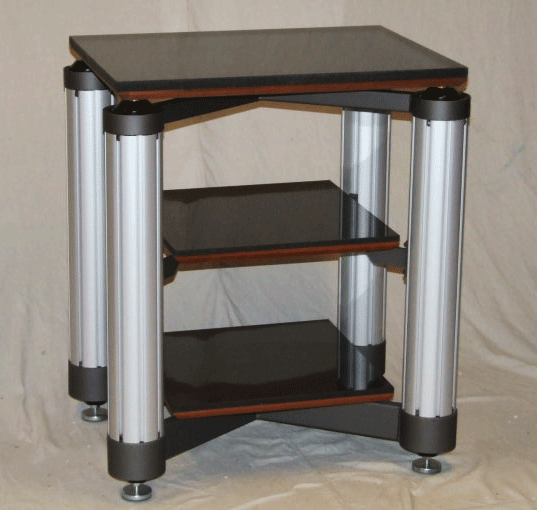
For me, one of the things that I love about high-end audio is the never-ending marriage of art and science. Just take a look at the miniature sculptures that most phono-cartridges have become, combining esoteric materials such as specially cured woods and scientifically formed alloy metals and plastics with wires made from copper or silver or pure virgin Tibetan llama’s wool. Okay, so maybe that last one might be a bit of a stretch, but don’t be surprised if the good folks over at Clearaudio figure out how to pull that one off too.
All kidding aside, what I’m trying to say is that the high-end audio industry never fails to take the seemingly mundane and produce scientific and artistic brilliance. A case in point would be the Zero GXT equipment rack from Adona Corporation.
Now I’ll be the first to admit that when I’m talking about all the components in my reference system to my non-audiophile friends, the stand or cabinet that the components are sitting on is never part of the conversation. Frankly, whenever I thought of high-end audio equipment racks, I often thought of those ugly, uninspiring black iron racks from companies like Target and Premier. They were also fairly messy to work with as you had to add sand or lead shot to them in order to give them enough mass. So when I was asked to contact Paul Lemanski of Lizella, Georgia based Adona Corporation to enquire about reviewing one of their racks, I was somewhat intrigued but didn’t have any real expectations of a rack making a significant impact on my system. I often use amp stands but only because giant monoblock amps like the BAT VK1000 and XLH M-2000 simply won’t fit in my entertainment center. And my entertainment center is a huge, massive solid wood structure that handles all of my components with relative ease… or so I thought. The pitfalls of using an entertainment center were laid before me when I tried using my brother’s Merrill Heirloom turntable in it, not good, musically speaking.
About the Company
Adona Corporation is a manufacturer of high-end audio racks that are beautifully designed to minimize resonance, provide maximum shelf space flexibility, and do so using high quality materials while still preserving reasonable price points.
The company is led by Paul and Ronee Lemanski. Paul is a former Director of Engineering at Altek Corporation, which makes precision measuring devices. He has more than twenty years of experience in what it takes to design a product and bring it to market. Ronee is a performer (acting and singing) who also brings a wide variety of business skills to the company from her days as an accountant at the Washington Music Center in Wheaton, Maryland, and is now the Director of Sales and Marketing for Adona Corporation.
The Zero GXT
The key technology in the Adona Zero GXT is the multi-layered design of its shelves. They combine the advantages of several different material technologies. The genuine granite top layer provides stunning beauty, an extremely hard surface and high mass, while the inner conduction layer operates as a band-pass filter, as it transfers energy to the lower damping layer. The following is a more detailed description of the shelves from the Adona website:
The Top Surface:
The granite top layer is formed by a natural process involving intense heat and extreme pressure and then cooled down slowly to form a substance approaching the hardness and durability of a diamond. Granite is an igneous rock that is predominantly composed of four minerals: quartz, feldspar, mica, and usually hornblende. In addition, magnetite, hematite, pyrite, zircon, garnet, corundum and other minerals may be present in smaller amounts, adding to the unique coloration and texture of each granite deposit. These minerals occur in different proportions, depending on the location of the quarry, giving each granite layer its own color, texture and structural characteristics. Not all varieties of granite are suitable in audio applications. As a matter of fact, most are quite nasty. Adona holds very tight criteria for the actual species of stone used in its platforms.
Extensive testing has determined that the usable thickness lands within a very small range, centered at about 1.5cm or just under 5/8 of an inch. Granite 0.75 inches or thicker tends to not be “elastic” enough for proper damping to be obtained. Granite much less than 0.50 inches thick will lack structural integrity and does not provide sufficient mass to fully benefit from the effects of inertia. The stone used in Adona platforms typically ranges from about 0.55 to 0.62 inches thick.
The Core:
The inner conduction layer measures only a few thousands of an inch thick and is visible merely as a parting line when viewed from the edge of the platform. We often here people on the web refer to this as “the mystery layer” as we don’t disclose many details about it. I have spoke with many customers that have attempted build their own version, and it seems that people believe this to be a damping layer, and have tried elastic materials. This actually defeats the intended purpose and is not much different than using untreated granite by itself. Thin-set mortar and contact cement don’t seem to work well either. We use a product borrowed from the aerospace industry, combined with a two-part, catalyzed chemical adhesive process that “soaks” into the substrate and actually alters the surface properties of the MDF.
With the implementation of our proprietary inner conduction layer, and complete absence of viscoelastic barrier materials, the platform behaves in a monolithic manner. The granite and substrate interact with each other, rather than just being “isolated” from each other. This means that the performance is reliable, regardless of load conditions, weight distribution or platform orientation. By platform orientation, we mean you can achieve different, but predictable results using either side as the top surface. This is the industry’s first and only “functionally-reversible” platform. With the granite side facing up, you’ll achieve a more lively sound, and with the substrate side facing up, you’ll get a mellow and more restrained sound. Although 99 percent of the time the “granite-side-up” offers the best performance, in some situations, reversing one of the platforms in your rack just may do the trick!
The Substrate
This is our compensation medium and is used to selectively “drain” energy from the granite top surface. MDF (medium density fiberboard) was chosen because it absorbs vibration energy well and without contributing an appreciable amount of coloration to the equation.
We use premium quality, furniture-grade MDF. The MDF you find at the “Big Box” is far too inconsistent to expect any reliable results. It can range from a light tan color to a dark brown, or anything in between. This is due to varying amounts of resin needed in the mixture depending on the batch of pulp used at the time.
Medium-density fiberboard is an engineered wood product formed by breaking down softwood into wood fibers, combining it with wax and a resin binder, and forming panels by applying high temperature and pressure. The wood fibers are categorized as lignocellulosic, which includes any substance that contains both cellulose and lignin. It is this combination of wood fibers with the sealers and binding materials, that gives MDF its characteristic “damping” quality.
MDF is considered a composite material, which can be defined as any combination of two or more materials, in any form, and for any use. In the wood industry, the terms composite and reconstituted wood are usually used to describe any wood product that is “glued” together.
Standard platforms have the substrate coated with a black finish. For a small additional charge, the platforms are also available with a solid hard-wood trim applied over the MDF substrate.
That’s a lot of technology to go in to something as simple as a shelf, but as you’ll read later in this review, the end result wholly justifies all the work that goes into designing this rack.
The Zero GXT Frame
The frame consist of four elegantly styled, 4.5” diameter precision extruded aluminum columns which are attached to top and bottom “cross beams” that are made of high-mass structural steel and have very different properties from the columns. This helps to prevent a phenomenon called “cage effect.” The crossbeams are much denser and less resonant than the columns. These columns can also be filled to add more mass but I never felt the need to do that with this rack.
Independent shelving brackets are used to allow the user to have full flexibility in shelving height. These brackets are machined from 3/4″ thick, solid billet aluminum and weigh almost a half a pound each. The top shelf, which is specifically designed for turntables, is 27” wide X 21” deep. The lower shelves are 18” X 18”. The shelves can handle any component, from a small tube DAC to a massive solid-state power amp, allowing you to direct-couple or float your platforms. Each shelf is designed to hold up to 300 lbs. All Zero Series racks come standard with direct-couple leveling devices; a very thoughtful touch. A matching amp stand is also available and the rack can be ordered with 2, 3, 4, 5 or 6 shelves.
The rack I was sent also came with two types of footers: Floor discs and some fairly massive spiked brass cones. Adona Corporation also offers casters and floor glides. These folks have really thought of everything and everything is nicely executed.
Assembly was shockingly simple. It only took me about 30 minutes to put the rack together, and you’re talking about someone who could get stiff competition from Helen Keller in assembling an eight piece jigsaw puzzle.
Listening
Okay, so we’ve established that the Adona Corporation Zero GXT equipment rack is a gorgeous, well designed and thoughtfully executed piece of furniture, but at $2,400 it is reasonably priced but hardly inexpensive. So the most important question that needs to be answered is what impact will it have on an audio system?
I have a relatively flat Berber carpet on my listening room floor, so I was initially able to use the supplied floor discs. The rack’s own mass and the weight of the components that I placed on it provided suitable enough coupling to the floor. I was using the Classe’ Audio CA-M600 mono amps on the two lower shelves and a Klyne Seven preamp on the top shelf.
I began listening to songs from my iTunes library, streamed from my Apple TV to a City Pulse Audio DA2.03e DAC’s optical input, which fed the Klyne. I had already been using Osiris amp stands for the Classe’ amps, so the improvement in clarity and focus that I heard told me that the Klyne preamp was the immediate beneficiary of the Adona rack. After reading all of the great, detailed information that is provided on the Adona website (recommended reading to fully appreciate this rack) I would say that the initial impressions simply met my lofty expectations of a $2,400 rack.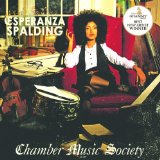 Hearing Esperanza Spaulding’s mellifluous vocals on “Apple Blossom,” the sixth track from her brilliant, Chamber Music Society album [Heads Up International] was a renewed experience for me. The pluck of the strings on her acoustic bass was tighter and airier than when the Klyne sat in my entertainment center. The same could be said of track three, “Really Very Small.” Spaulding’s voice on this track and the entire disc really, are reminiscent of singers like Basia and Astrud Gilberto. The Zero GXT’s ability to allow the signal to travel through your components, unencumbered by resonance manifests itself in a holographically rendered soundstage.
Hearing Esperanza Spaulding’s mellifluous vocals on “Apple Blossom,” the sixth track from her brilliant, Chamber Music Society album [Heads Up International] was a renewed experience for me. The pluck of the strings on her acoustic bass was tighter and airier than when the Klyne sat in my entertainment center. The same could be said of track three, “Really Very Small.” Spaulding’s voice on this track and the entire disc really, are reminiscent of singers like Basia and Astrud Gilberto. The Zero GXT’s ability to allow the signal to travel through your components, unencumbered by resonance manifests itself in a holographically rendered soundstage.
Turning to a Turntable
But to be honest, the real reason that I wanted to review this rack wasn’t because I thought it would make a great impact on my electronics; the fact that it did was gravy. My real reason for wanting to check out this rack was to see the job it could do with a turntable as the system’s source. I have had a few turntables in my day and they have sat on everything from massive wood entertainment centers to Target stands to a pair of mono amps… That’s right; I once sat an old Linn LP12 atop a stacked pair of Electrocompaniet Nemos. The results, while not bad were hardly optimal, so I borrowed my brother’s Merrill for this review. It was outfitted with a Jeff Rowland Compliment tonearm and Transfiguration Phoenix cartridge. I set this rig up in my entertainment center for about a week just to establish a benchmark. I was actually quite surprised that the music didn’t sound that bad; foot-fault wasn’t a problem and the sound didn’t seem to be compromised at all. I did have one little mishap when I tossed my Boston Terrier Max’s chew toy a little too close to the center and zzzzzuuuuupppp! went the stylus across the record.
I took that as a sign that it was time to set up the Merrill on the Adona rack. First though, I repositioned the rack to make access to all sides of it as easy as possible. I then installed the massive spiked brass cones and sat Entreq Audio “Vibbeaters” on the bottom two shelves to add mass. I waited a couple of days while the weight of the rack and everything on it pierced the Berber carpet, settling nicely into the floor.
I began listening to the 180gm pressing of Pat Coil’s Steps [Sheffield Labs]. When the first note of track one, “Sierra Highways,” began to play, my reaction was a spontaneous, “Oh baby.” The background was dead quiet, and the soundstage was rendered spaciously and naturally. I have always loved the manner in which Sheffield Labs seems to emphasize the realism of percussion instruments. The kick drum on this tune was nice and tight sounding, but more than that, when you hear Coil on the piano, you are reminded that a piano is essentially a percussion instrument. Piano hammers striking strings make a distinct sound and that came through in spades as I continued to listen.
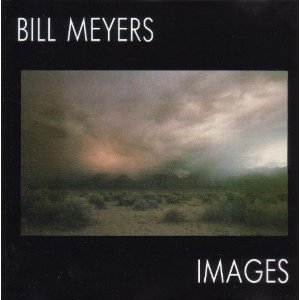 I noticed the same thing on Bill Meyers’ wonderful but rare album, Images [Spindletop]. The first track “AM” starts with an alarm clock going off, and again there’s that unique sound that this time was made by a small hammer rapidly hitting the alarm bell; it’s really neat to hear. It’s a further testament to what it means to have a solid foundation for your source components. The music on this album is loaded with dynamics and they’re laid out splendidly thanks to the effect of this rack.
I noticed the same thing on Bill Meyers’ wonderful but rare album, Images [Spindletop]. The first track “AM” starts with an alarm clock going off, and again there’s that unique sound that this time was made by a small hammer rapidly hitting the alarm bell; it’s really neat to hear. It’s a further testament to what it means to have a solid foundation for your source components. The music on this album is loaded with dynamics and they’re laid out splendidly thanks to the effect of this rack.
I was also reminded of what it is that I miss about the sound of vinyl. The absence of resonance from the table allowed me to hear deeper into the music, and I found myself poring over stacks of LPs that I hadn’t heard in years. In short, the Adona rack was allowing me to just enjoy music and not think about background noise or trying to tip-toe around the rack so as not to cause the stylus to skip.
Conclusion
It should also not be taken for granted that the Adona Zero GXT equipment rack has a high “Spouse Acceptancy Factor” (SAF). It is a gorgeous piece of furniture. The soft silver sculpted columns, natural stone shelves, and generous size, makes this a rack that draws immediate attention. I’ve been to friends’ homes who were using milk crates, marble slabs bolted to woodblocks and everything in between. And while some of those things may be viable solutions to them, it also makes their rooms look butt-ugly. The stylish and elegant looks of the Adona rack improve the looks of your room as well as your system’s sound. That is what I call a wonderful marriage of art and science.

![]()
Specifications:
Zero GXT Equipment Rack
Shipping weight 185 lbs. (3-shelf version)
Load capacity: 300 pounds per shelf
Overall Dimensions (with three shelves: Width 27.5″, Depth 22″, height 32″ (other heights available)
Platform size: Includes two Standard 18″x18″ and one oversize 21″x27″
Maximum component size: Lower shelves: 19.5″ wide, 24″ deep
Maximum component size: Turntable top shelf: 27″ wide, 21″ deep
Shelf spacing: Infinitely adjustable
Price: $2400.00
Address:
Adona Corporation
Lizella, GA 31052
Phone: (478) 781-3400
Website: http://www.adonacorporation.com
Email: adonacorp@hotmail.com
![]()
Don’t forget to bookmark us! (CTRL-SHFT-D)
Stereo Times Masthead
Publisher/Founder
Clement Perry
Editor
Dave Thomas
Senior Editors
Frank Alles, Mike Girardi, Russell Lichter, Terry London, Moreno Mitchell, Paul Szabady, Bill Wells, Mike Wright, and Stephen Yan,
Current Contributors
David Abramson, Tim Barrall, Dave Allison, Ron Cook, Lewis Dardick, John Hoffman, Dan Secula, Don Shaulis, Greg Simmons, Eric Teh, Greg Voth, Richard Willie, Ed Van Winkle, Rob Dockery, Richard Doran, and Daveed Turek
Site Management Clement Perry
Ad Designer: Martin Perry


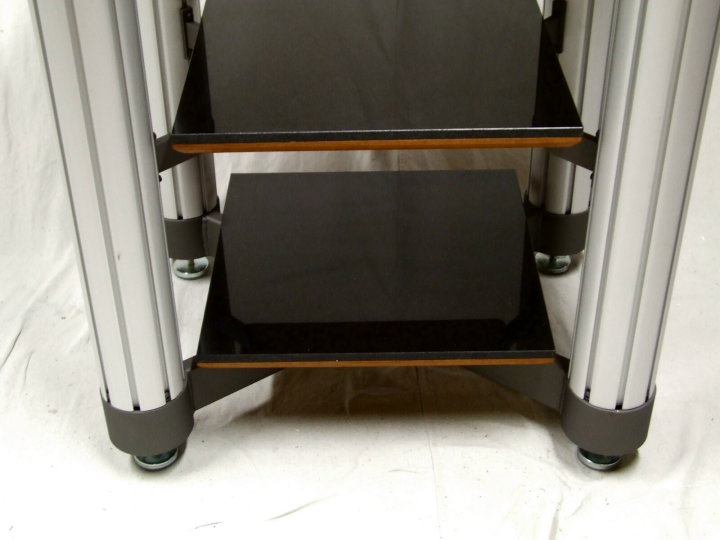
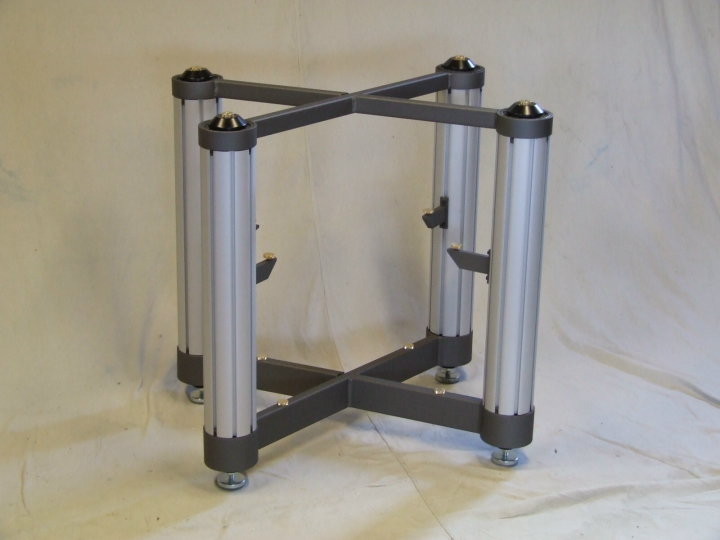



Be the first to comment on: Adona Corporation Zero GXT Equipment Rack